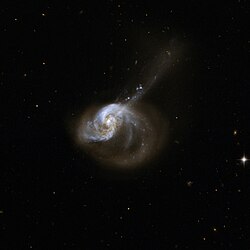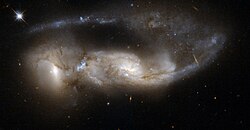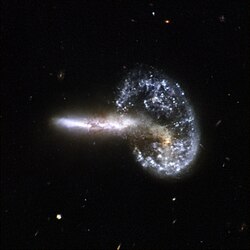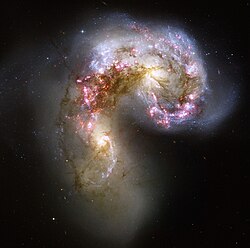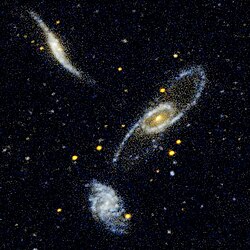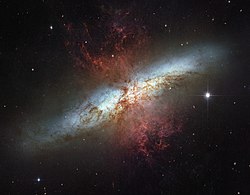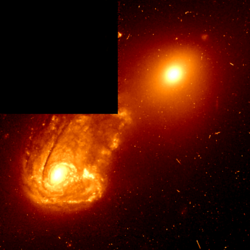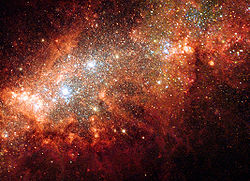Hubble Interacting Galaxy NGC 5754 (2008-04-24)
This beautiful pair of interacting galaxies consists of NGC 5754, the large spiral on the right, and NGC 5752, the smaller companion in the bottom left corner of the image. NGC 5754's internal structure has hardly been disturbed by the interaction. The outer structure does exhibit tidal features, as does the symmetry of the inner spiral pattern and the kinked arms just beyond its inner ring. In contrast, NGC 5752 has undergone a starburst episode, with a rich population of massive and luminous star clusters clumping around the core and intertwined with intricate dust lanes. The contrasting reactions of the two galaxies to their interaction are due to their differing masses and sizes. NGC 5754 is located in the constellation Bootes, the Herdsman, some 200 million light-years away.
This image is part of a large collection of 59 images of merging galaxies taken by the Hubble Space Telescope and released on the occasion of its 18th anniversary on 24th April 2008.
| About the object | |
|---|---|
| Object name | NGC 5754, NGC 5752, NGC 5752/4, Arp 297 |
| Object description | Interacting Galaxies |
| Position (J2000) | 14 45 19.64 +38 43 54.0 |
| Constellation | Bo tes |
| Distance | 200 million light-years (50 million parsecs) |
| About the data | |
| Data description | The Hubble image was created using HST data from proposal 7467: W. Keel (University of Alabama, Tuscaloosa) |
| Instrument | WFPC2 |
| Exposure date(s) | March 14, 1999 |
| Exposure time | 1.4 hours |
| Filters | F435W (B) and F814W (I) |
| This file is in the public domain because it was created by NASA and ESA. NASA Hubble material (and ESA Hubble material prior to 2009) is copyright-free and may be freely used as in the public domain without fee, on the condition that only NASA, STScI, and/or ESA is credited as the source of the material. This license does not apply if ESA material created after 2008 or source material from other organizations is in use. The material was created for NASA by Space Telescope Science Institute under Contract NAS5-26555, or for ESA by the Hubble European Space Agency Information Centre. Copyright statement at hubblesite.org or 2008 copyright statement at spacetelescope.org. For material created by the European Space Agency on the spacetelescope.org site since 2009, use the {{ESA-Hubble}} tag. |
Relevante Bilder
Relevante Artikel
Atlas of Peculiar GalaxiesDer Atlas of Peculiar Galaxies ist ein astronomischer Katalog. In ihm sind 338 ungewöhnliche Galaxien mit photographischen Aufnahmen aufgeführt. .. weiterlesen
NGC 5752NGC 5752 ist eine Spiralgalaxie in Kantenstellung vom Hubble-Typ Sb im Sternbild Bärenhüter am Nordsternhimmel. Sie ist etwa 207 Millionen Lichtjahre von der Milchstraße entfernt und hat einen Durchmesser von etwa 45.000 Lichtjahren. Die Galaxie steht in wechselwirkender Beziehung zu NGC 5754 und bildet mit ihr und NGC 5753 und NGC 5755 ein Quartett namens Arp 297. Halton Arp gliederte seinen Katalog ungewöhnlicher Galaxien nach rein morphologischen Kriterien in Gruppen. Dieses Galaxienpaar gehört zu der Klasse Galaxien mit langen Filamenten. .. weiterlesen
NGC 5754NGC 5754 ist eine Balkenspiralgalaxie vom Hubble-Typ SB(rs)b im Sternbild Bärenhüter am Nordsternhimmel. Sie ist rund 208 Millionen Lichtjahre von der Milchstraße entfernt und hat einen Durchmesser von etwa 75.000 Lichtjahren. Durch die interaktive Beziehung mit ihrer kleineren Begleiterin NGC 5752 wurden ihre Spiralarme auseinandergezogen. Gemeinsam mit NGC 5753 und NGC 5755 bildet sie das optische Quartett Arp 297. Halton Arp gliederte seinen Katalog ungewöhnlicher Galaxien nach rein morphologischen Kriterien in Gruppen. Dieses Galaxienpaar gehört zu der Klasse Galaxien mit langen Filamenten. .. weiterlesen



